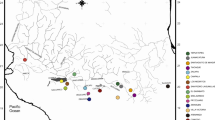Abstract
Littoraria cingulata (Philippi, 1846) is a Western Australian, mangrove littorine snail, represented by two morphologically distinct subspecies, whose distributions are separated by >300 km. The southern subspecies, L. cingulata pristissini, is distinguished from the northern subspecies, L. cingulata cingulata, by having a thinner, keelless shell with more primary grooves, and lower and much more numerous ribs. In contrast with these striking differences, L. cingulata cingulata is morphologically very similar to another species, L. sulculosa, with which it also shares a nearly coincident geographic range. Allozyme comparisons at 22 presumptive loci confirmed a large genetic distance between L. cingulata and L. sulculosa, and the apparent conspecificity of the morphologically divergent subspecies of L. cingulata. Based on geological evidence, the geographical separation of the morphologically divergent forms of L. cingulata has developed within the past 5000 to 10 000 yr. The extensive continuous distribution of the northern subspecies, L. cingulatacingulata, and the large geographic disjunction between the northern and Shark Bay subspecies, L. cingulata pristissini, allowed a test of the genetic importance of this relatively recent disjunction. Within the continuous distribution of the two subspecies, a pattern of isolation by distance was visible up to distances of 300 km. Beyond 300 km, genetic subdivision, measured by pairwise G ST (the proportion of genetic diversity due to differences between populations), averaged 0.028, whereas subdivision between Shark Bay and northern populations averaged 0.055 over the same range of distances. Although the relative paucity of barriers to gene flow tends to limit genetic subdivision in marine species with planktotrophic larvae, the results for L. cingulata suggest that subdivision can occur within a continuous distribution, but that special events leading to major disjunctions can substantially increase divergence, even over a relatively short period of time.
Similar content being viewed by others
Author information
Authors and Affiliations
Additional information
Received: 16 February 1998 / Accepted: 23 April 1998
Rights and permissions
About this article
Cite this article
Johnson, M., Black, R. Effects of isolation by distance and geographical discontinuity on genetic subdivision of Littoraria cingulata. Marine Biology 132, 295–303 (1998). https://doi.org/10.1007/s002270050395
Issue Date:
DOI: https://doi.org/10.1007/s002270050395




